 Technology peripherals
Technology peripherals
 AI
AI
 Able to align humans without RLHF, performance comparable to ChatGPT! Chinese team proposes Wombat model
Able to align humans without RLHF, performance comparable to ChatGPT! Chinese team proposes Wombat model
Able to align humans without RLHF, performance comparable to ChatGPT! Chinese team proposes Wombat model
OpenAI’s ChatGPT is able to understand a wide variety of human instructions and perform well in different language tasks. This is possible thanks to a novel large-scale language model fine-tuning method called RLHF (Aligned Human Feedback via Reinforcement Learning).
The RLHF approach unlocks the language model’s ability to follow human instructions, making the language model’s capabilities consistent with human needs and values.
Currently, RLHF’s research work mainly uses the PPO algorithm to optimize language models. However, the PPO algorithm contains many hyperparameters and requires multiple independent models to cooperate with each other during the algorithm iteration process, so wrong implementation details may lead to poor training results.
At the same time, from the perspective of alignment with humans, reinforcement learning algorithms are not necessary.
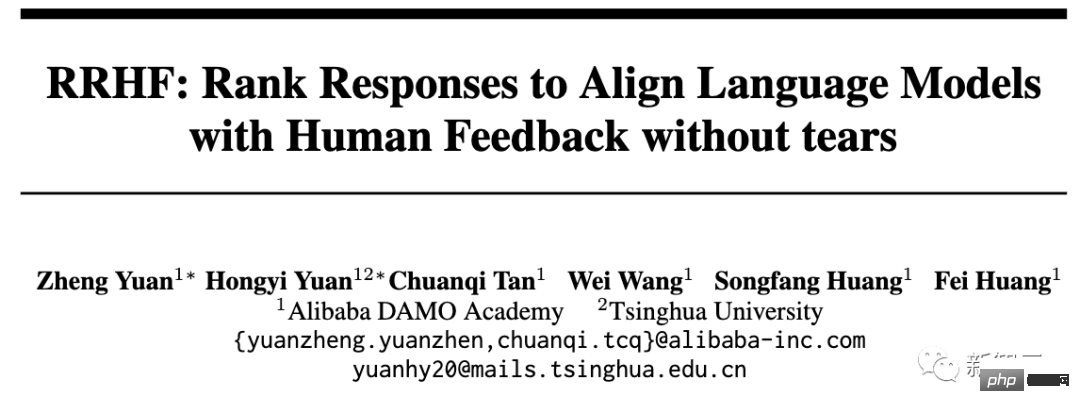
##Paper address: https://arxiv.org/abs/2304.05302v1
Project address: https://github.com/GanjinZero/RRHF
For this purpose, Alibaba Authors from DAMO Academy and Tsinghua University proposed a method called ranking-based human preference alignment—RRHF.
RRHF No reinforcement learning is required and responses generated by different language models can be leveraged, including ChatGPT, GPT-4, or current training models . RRHF works by scoring responses and aligning them with human preferences through a ranking loss.
Unlike PPO, the training process of RRHF can use the output of human experts or GPT-4 as comparison. The trained RRHF model can be used as both a generative language model and a reward model.
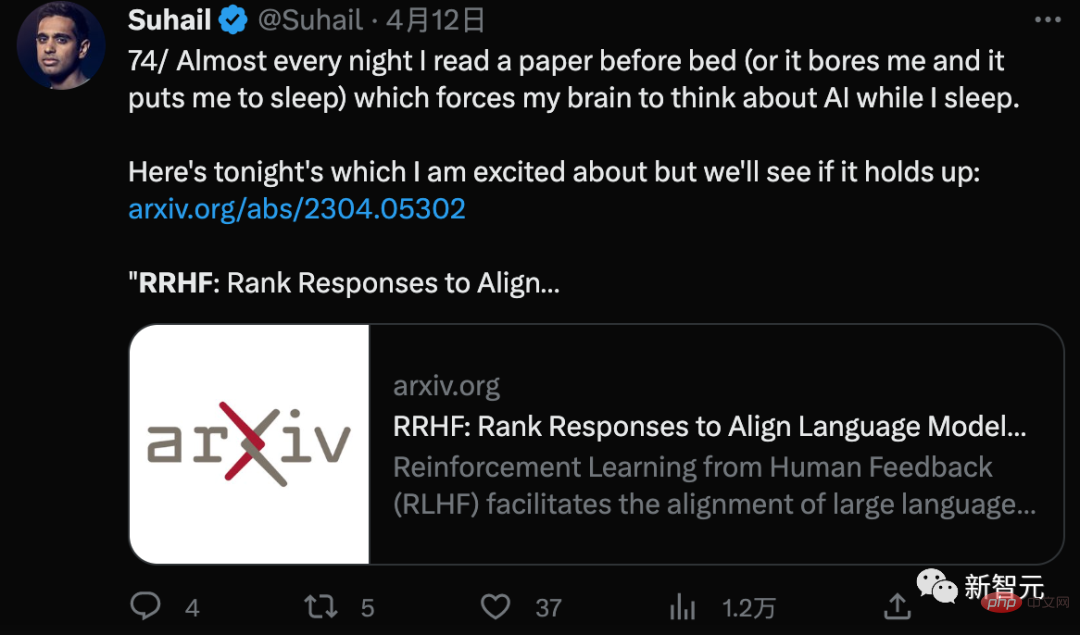
The CEO of Playgound AI said that this is the most interesting paper recently
The following figure compares the difference between the PPO algorithm and the RRHF algorithm.
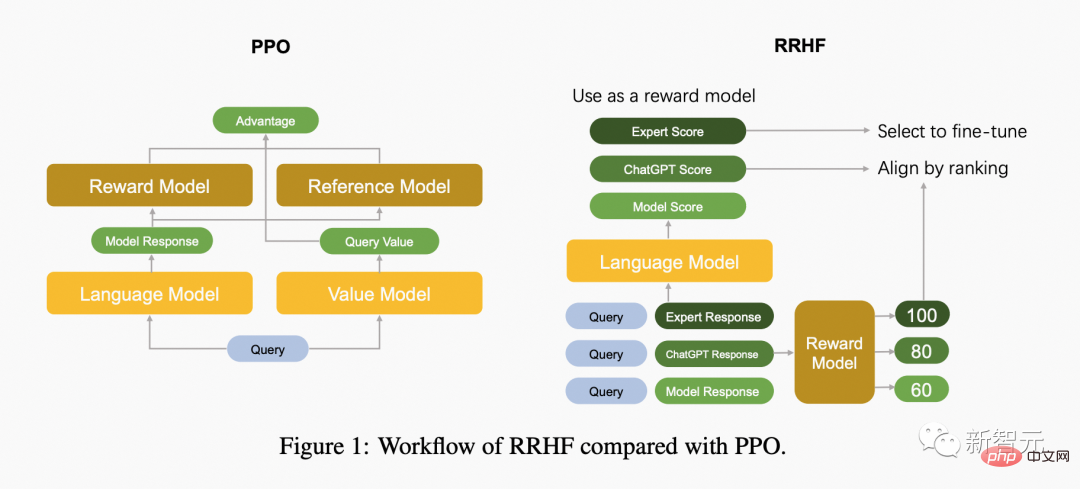
RRHF first obtains k replies through different methods, and then uses the reward model to respond to the k replies Each response is scored separately. Each response is scored using logarithmic probability:

where is the autoregressive language model Probability distributions.
We hope that the reward model will give a higher probability to the reply with a high score, that is, we hope to match the reward score. We optimize this goal through ranking loss:

In addition, we also give the model a goal to directly learn the highest score Reply:

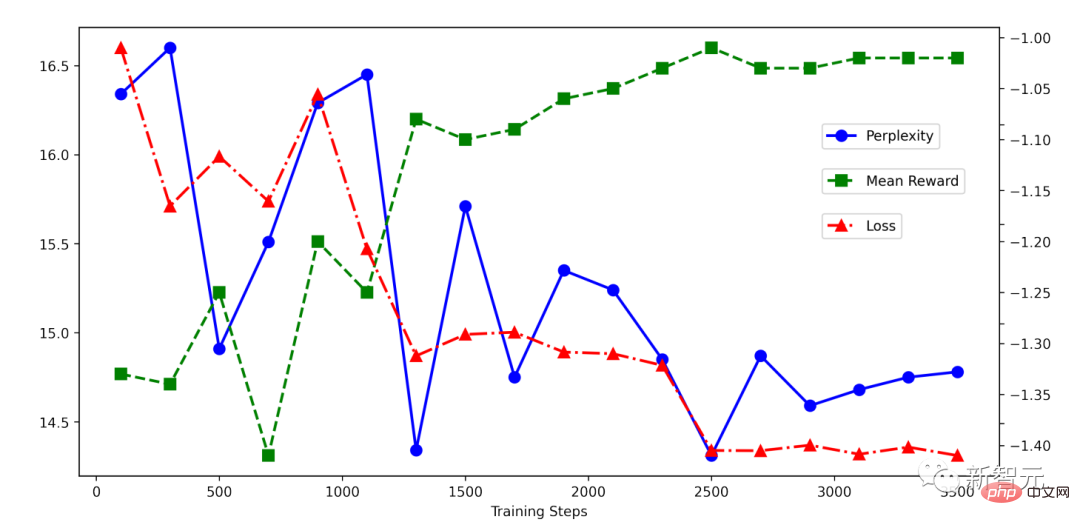
The author of the article conducted experiments on the HH data set and can also see effects comparable to PPO:
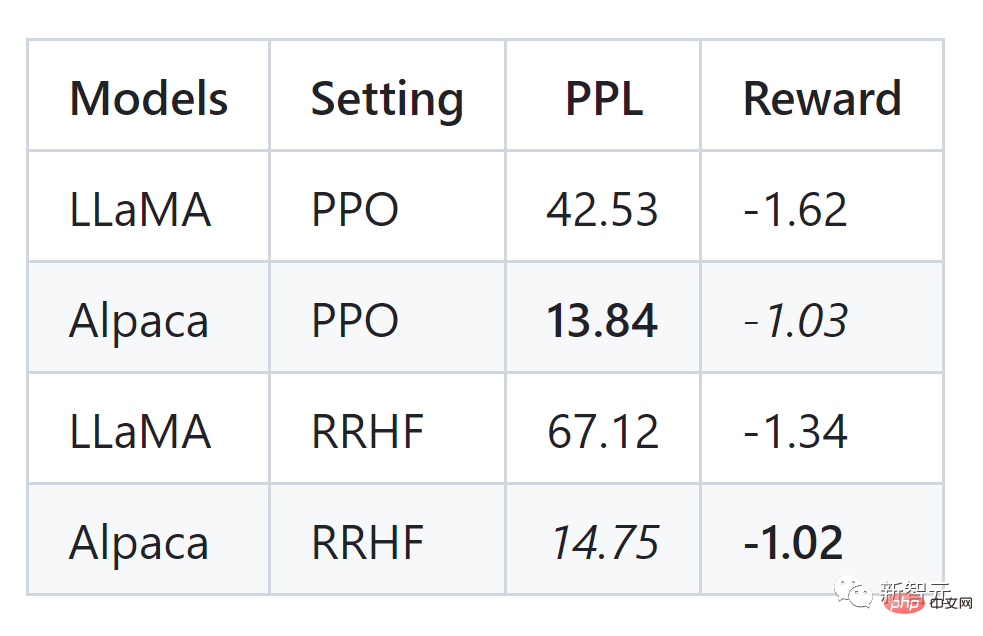
The RRHF algorithm can effectively align the language model output probability with human preferences. Its training idea is very simple. The trained model has several characteristics:
- Only 1 to 2 models are required, while PPO requires 4 models, so the RRHF algorithm is simpler and more efficient.
- Supervised fine-tuning (SFT) can be regarded as a special form of the RRHF algorithm.
- The RRHF algorithm can be used as both a language model and a reward model.
- The RRHF algorithm can fit the preference of the reward model at a lower training difficulty, achieve the effect of the PPO algorithm, and avoid the complexity and instability problems in the PPO algorithm.
The RRHF method uses OpenAI's chatGPT or GPT-4 as the scoring model and the output of ChatGPT, Alpaca and other models as training samples to develop two new language models, respectivelyWombat-7B and Wombat-7B-GPT4. The training time ranges from 2-4 hours and is very lightweight.
Wombat Wombat, as a new open source pre-training model, can better align with human preferences compared to LLaMA, Alpaca, etc. The authors experimentally found that Wombat-7B has complex abilities such as role playing and counterfactual reasoning.
If Wombat were asked to introduce the future technology from 3000, Wombat would answer like this (translated from English):
- As a person from 3000 As a time traveler for many years, I have been privileged to witness many revolutionary technological advances. One of the most important technological advances that I want to share with modern people is the development of artificial intelligence (AI) technology. AI technology has advanced to a point where it has become an integral part of our daily lives. It has been used to develop smart machines that can perform a wide range of tasks, from driving cars to diagnosing medical conditions. AI technology is also being used to create virtual assistants like Siri and Alexa that can answer questions, schedule appointments, and even order groceries. Another technological advance I would like to highlight is the development of renewable energy. In the year 3000, nearly all of our energy needs were met by renewable energy sources such as solar, wind and hydropower. This significantly reduces our carbon footprint and helps mitigate the effects of climate change. Finally, I would like to mention the advancements in space exploration. In the year 3000, humans have been able to explore and colonize several planets beyond our solar system. Space travel has become faster, safer and easier thanks to advanced propulsion systems and the use of artificial intelligence to navigate and explore new worlds. Overall, the technological advancements I mentioned are just a few examples of the many innovations that have been developed over the years. As time travelers, we have witnessed firsthand the amazing advancements humans have made in technology.
Hope our future will get better and better as Wombat predicted.

References:
https://github.com/GanjinZero/RRHF
The above is the detailed content of Able to align humans without RLHF, performance comparable to ChatGPT! Chinese team proposes Wombat model. For more information, please follow other related articles on the PHP Chinese website!

Hot AI Tools

Undresser.AI Undress
AI-powered app for creating realistic nude photos

AI Clothes Remover
Online AI tool for removing clothes from photos.

Undress AI Tool
Undress images for free

Clothoff.io
AI clothes remover

AI Hentai Generator
Generate AI Hentai for free.

Hot Article

Hot Tools

Notepad++7.3.1
Easy-to-use and free code editor

SublimeText3 Chinese version
Chinese version, very easy to use

Zend Studio 13.0.1
Powerful PHP integrated development environment

Dreamweaver CS6
Visual web development tools

SublimeText3 Mac version
God-level code editing software (SublimeText3)

Hot Topics
 1384
1384
 52
52
 The world's most powerful open source MoE model is here, with Chinese capabilities comparable to GPT-4, and the price is only nearly one percent of GPT-4-Turbo
May 07, 2024 pm 04:13 PM
The world's most powerful open source MoE model is here, with Chinese capabilities comparable to GPT-4, and the price is only nearly one percent of GPT-4-Turbo
May 07, 2024 pm 04:13 PM
Imagine an artificial intelligence model that not only has the ability to surpass traditional computing, but also achieves more efficient performance at a lower cost. This is not science fiction, DeepSeek-V2[1], the world’s most powerful open source MoE model is here. DeepSeek-V2 is a powerful mixture of experts (MoE) language model with the characteristics of economical training and efficient inference. It consists of 236B parameters, 21B of which are used to activate each marker. Compared with DeepSeek67B, DeepSeek-V2 has stronger performance, while saving 42.5% of training costs, reducing KV cache by 93.3%, and increasing the maximum generation throughput to 5.76 times. DeepSeek is a company exploring general artificial intelligence
 AI subverts mathematical research! Fields Medal winner and Chinese-American mathematician led 11 top-ranked papers | Liked by Terence Tao
Apr 09, 2024 am 11:52 AM
AI subverts mathematical research! Fields Medal winner and Chinese-American mathematician led 11 top-ranked papers | Liked by Terence Tao
Apr 09, 2024 am 11:52 AM
AI is indeed changing mathematics. Recently, Tao Zhexuan, who has been paying close attention to this issue, forwarded the latest issue of "Bulletin of the American Mathematical Society" (Bulletin of the American Mathematical Society). Focusing on the topic "Will machines change mathematics?", many mathematicians expressed their opinions. The whole process was full of sparks, hardcore and exciting. The author has a strong lineup, including Fields Medal winner Akshay Venkatesh, Chinese mathematician Zheng Lejun, NYU computer scientist Ernest Davis and many other well-known scholars in the industry. The world of AI has changed dramatically. You know, many of these articles were submitted a year ago.
 Google is ecstatic: JAX performance surpasses Pytorch and TensorFlow! It may become the fastest choice for GPU inference training
Apr 01, 2024 pm 07:46 PM
Google is ecstatic: JAX performance surpasses Pytorch and TensorFlow! It may become the fastest choice for GPU inference training
Apr 01, 2024 pm 07:46 PM
The performance of JAX, promoted by Google, has surpassed that of Pytorch and TensorFlow in recent benchmark tests, ranking first in 7 indicators. And the test was not done on the TPU with the best JAX performance. Although among developers, Pytorch is still more popular than Tensorflow. But in the future, perhaps more large models will be trained and run based on the JAX platform. Models Recently, the Keras team benchmarked three backends (TensorFlow, JAX, PyTorch) with the native PyTorch implementation and Keras2 with TensorFlow. First, they select a set of mainstream
 Hello, electric Atlas! Boston Dynamics robot comes back to life, 180-degree weird moves scare Musk
Apr 18, 2024 pm 07:58 PM
Hello, electric Atlas! Boston Dynamics robot comes back to life, 180-degree weird moves scare Musk
Apr 18, 2024 pm 07:58 PM
Boston Dynamics Atlas officially enters the era of electric robots! Yesterday, the hydraulic Atlas just "tearfully" withdrew from the stage of history. Today, Boston Dynamics announced that the electric Atlas is on the job. It seems that in the field of commercial humanoid robots, Boston Dynamics is determined to compete with Tesla. After the new video was released, it had already been viewed by more than one million people in just ten hours. The old people leave and new roles appear. This is a historical necessity. There is no doubt that this year is the explosive year of humanoid robots. Netizens commented: The advancement of robots has made this year's opening ceremony look like a human, and the degree of freedom is far greater than that of humans. But is this really not a horror movie? At the beginning of the video, Atlas is lying calmly on the ground, seemingly on his back. What follows is jaw-dropping
 KAN, which replaces MLP, has been extended to convolution by open source projects
Jun 01, 2024 pm 10:03 PM
KAN, which replaces MLP, has been extended to convolution by open source projects
Jun 01, 2024 pm 10:03 PM
Earlier this month, researchers from MIT and other institutions proposed a very promising alternative to MLP - KAN. KAN outperforms MLP in terms of accuracy and interpretability. And it can outperform MLP running with a larger number of parameters with a very small number of parameters. For example, the authors stated that they used KAN to reproduce DeepMind's results with a smaller network and a higher degree of automation. Specifically, DeepMind's MLP has about 300,000 parameters, while KAN only has about 200 parameters. KAN has a strong mathematical foundation like MLP. MLP is based on the universal approximation theorem, while KAN is based on the Kolmogorov-Arnold representation theorem. As shown in the figure below, KAN has
 Tesla robots work in factories, Musk: The degree of freedom of hands will reach 22 this year!
May 06, 2024 pm 04:13 PM
Tesla robots work in factories, Musk: The degree of freedom of hands will reach 22 this year!
May 06, 2024 pm 04:13 PM
The latest video of Tesla's robot Optimus is released, and it can already work in the factory. At normal speed, it sorts batteries (Tesla's 4680 batteries) like this: The official also released what it looks like at 20x speed - on a small "workstation", picking and picking and picking: This time it is released One of the highlights of the video is that Optimus completes this work in the factory, completely autonomously, without human intervention throughout the process. And from the perspective of Optimus, it can also pick up and place the crooked battery, focusing on automatic error correction: Regarding Optimus's hand, NVIDIA scientist Jim Fan gave a high evaluation: Optimus's hand is the world's five-fingered robot. One of the most dexterous. Its hands are not only tactile
 FisheyeDetNet: the first target detection algorithm based on fisheye camera
Apr 26, 2024 am 11:37 AM
FisheyeDetNet: the first target detection algorithm based on fisheye camera
Apr 26, 2024 am 11:37 AM
Target detection is a relatively mature problem in autonomous driving systems, among which pedestrian detection is one of the earliest algorithms to be deployed. Very comprehensive research has been carried out in most papers. However, distance perception using fisheye cameras for surround view is relatively less studied. Due to large radial distortion, standard bounding box representation is difficult to implement in fisheye cameras. To alleviate the above description, we explore extended bounding box, ellipse, and general polygon designs into polar/angular representations and define an instance segmentation mIOU metric to analyze these representations. The proposed model fisheyeDetNet with polygonal shape outperforms other models and simultaneously achieves 49.5% mAP on the Valeo fisheye camera dataset for autonomous driving
 DualBEV: significantly surpassing BEVFormer and BEVDet4D, open the book!
Mar 21, 2024 pm 05:21 PM
DualBEV: significantly surpassing BEVFormer and BEVDet4D, open the book!
Mar 21, 2024 pm 05:21 PM
This paper explores the problem of accurately detecting objects from different viewing angles (such as perspective and bird's-eye view) in autonomous driving, especially how to effectively transform features from perspective (PV) to bird's-eye view (BEV) space. Transformation is implemented via the Visual Transformation (VT) module. Existing methods are broadly divided into two strategies: 2D to 3D and 3D to 2D conversion. 2D-to-3D methods improve dense 2D features by predicting depth probabilities, but the inherent uncertainty of depth predictions, especially in distant regions, may introduce inaccuracies. While 3D to 2D methods usually use 3D queries to sample 2D features and learn the attention weights of the correspondence between 3D and 2D features through a Transformer, which increases the computational and deployment time.



